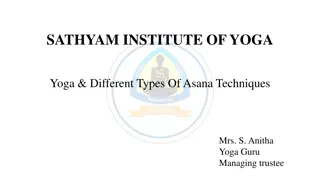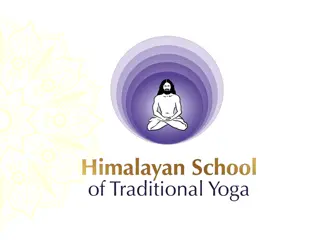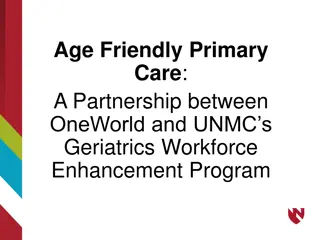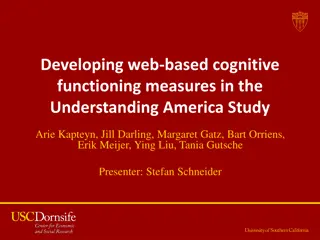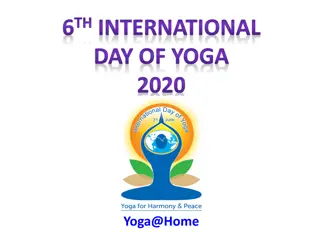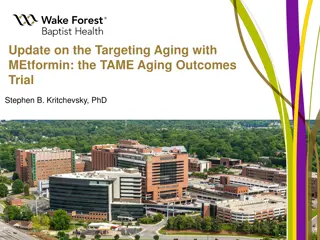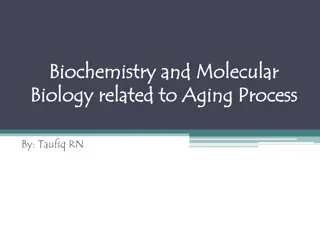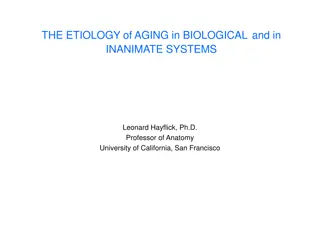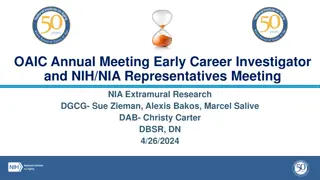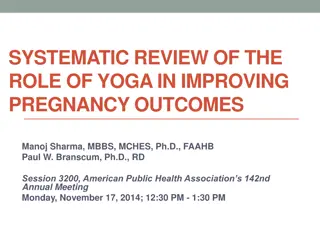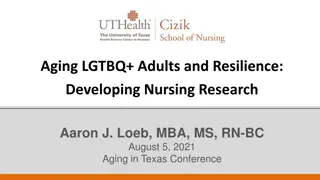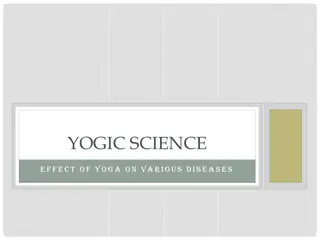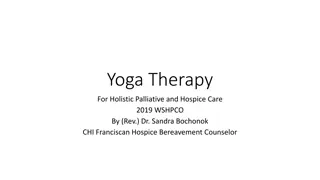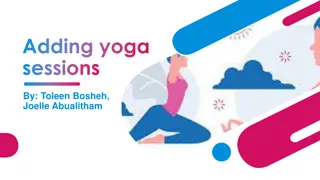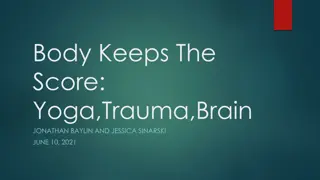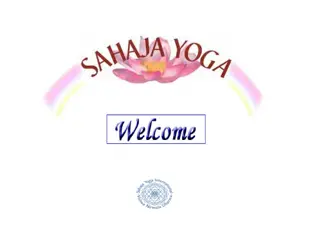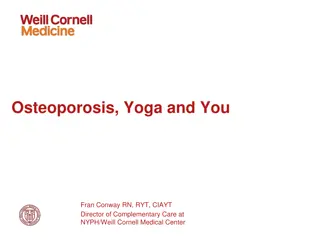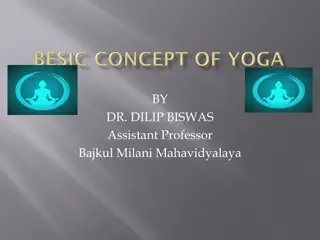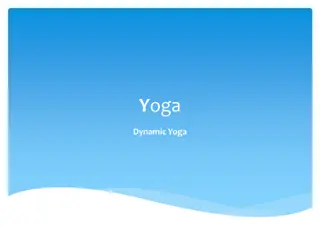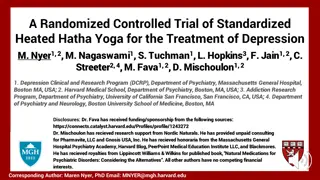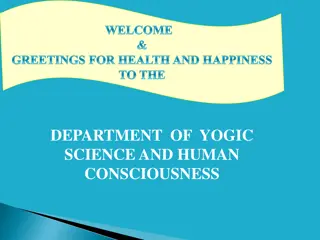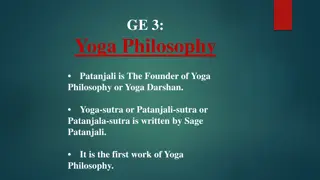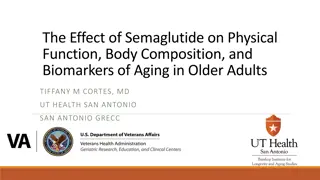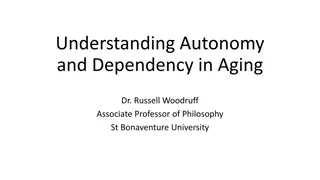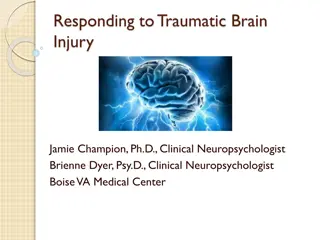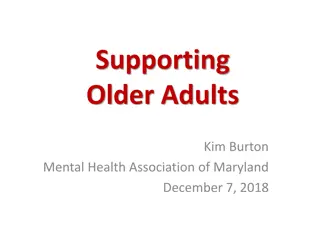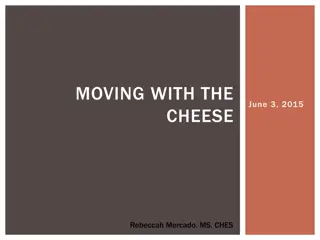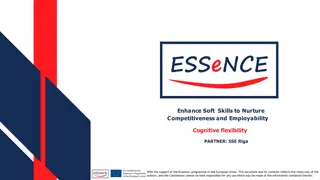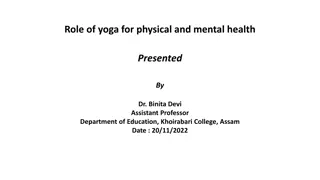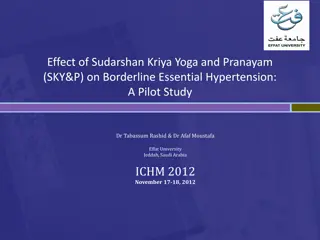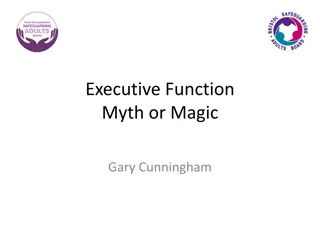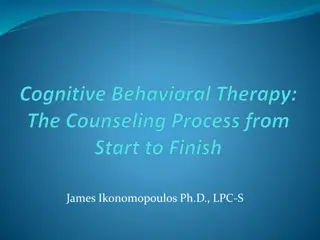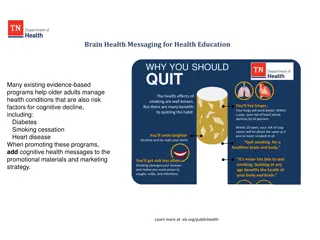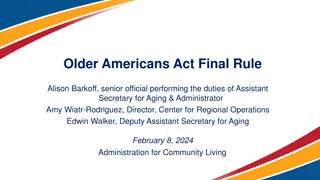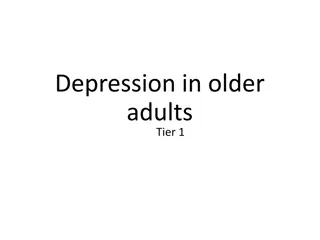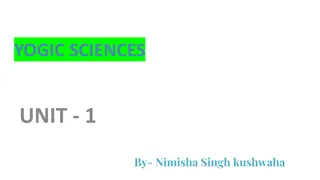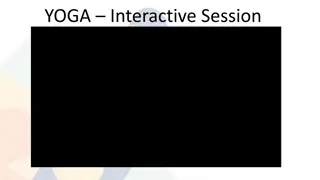Impact of Yoga on Cognitive Functioning in Aging Adults
Aging is often accompanied by a decline in cognitive functions, affecting areas such as memory, attention, and reasoning. This article explores the relationship between aging and cognitive impairment, along with various treatment options including drug therapy, dietary interventions, and cognitive exercises like yoga. Trataka, a yogic technique involving intense gazing to improve eye health and mental focus, is highlighted for its potential benefits in enhancing memory and concentration. Studies suggest that yoga practices can have a positive impact on cognitive abilities in both healthy individuals and those experiencing cognitive decline.
Download Presentation

Please find below an Image/Link to download the presentation.
The content on the website is provided AS IS for your information and personal use only. It may not be sold, licensed, or shared on other websites without obtaining consent from the author. Download presentation by click this link. If you encounter any issues during the download, it is possible that the publisher has removed the file from their server.
E N D
Presentation Transcript
BACKGROUND Aging is associated with a gradual impairment of cognitive functions (Curr Neurol Neurosci Rep, 2004) Cognitive functions most affected by age are Speed of processing Memory Attention Executive function Spatial ability Reasoning (Aging Health, 2010)
Treatment options for cognitive impairment- Drug Activity Diet Cognitive interventions Tai chi Yoga (Journal of the American Geriatrics Society, 2010; Dementia and Geriatric Cognitive Disorders, 2010; Neurosci Biobehav Rev, 2012; Journal of the South Carolina Medical Association, 2008)
Trataka is one of the Shatkarmas (six cleansing processes) (HYP) Looking intently with an unwavering gaze at a small point until tears are shed is known as Trataka (HYP)
Trataka practice makes eyes clear and bright. It improves memory and helps to develop good concentration and strong will power (Yoga publications trust, Munger, 2008) By practicing trataka, all the diseases of eyes are destroyed and clairvoyance Samhita) is obtained(Gheranda Trataka eradicates all eye diseases, fatigue and sloth and closes the doorway creating these problems(Hatha yoga pradipika)
Combination of focusing and defocusing through yoga reduces optical illusion more than focusing alone (Indian Journal of physiology & Pharmacology, 1997) Jyotritrataka reduces intraocular pressure in normal subjects (Thai Journal of Physiological Sciences, 2008) An increase in the CFF (perceptual accuracy) is seen immediately after Trataka (The Journal of Alternative and Complementary Medicine, 2010)
LITERATURE REVIEW Numerous studies looking at the effect of yoga on cognition in healthy young subjects (Percept Mot Skills, 2007; Indian J Physiol Pharmacol, 2009; Front Integr Neurosci, 2012 ) Review study-15 studies with cognitively healthy elders, 8 studies with cognitive decline-Improvement in most of the studies (Clin J Sports Med, 2008) Review of nine studies including 3 RCTs, 6 NRCT s-yoga improved cognitive health of older adults (Int J Yoga Therap, 2009)
Relaxation response training improved attention, memory in healthy elderly (Compl Ther Clin Pract, 2006) Long term practitioners of Vihangam yoga in the geriatric age group- better cognition (Neuropsychol Cogn, 2012) Study in SVYASA-improvement in semantic, primary, and working short term memory in healthy elderly subjects (SVYASA, 2005)
AIM & OBJECTIVES To study the effect of Trataka in the elderly on: Short term and working memory (digit span forward and backward) Executive functions (Trail making test B)
METHODOLOGY o Age & gender:- 60 to 80 yrs., Both males and females. o Subjects: Sample size:- n=60 Source of subjects:- Subjects were obtained from Old age homes in Goa and from individuals staying in and around Shantinagar and Margao areas in Goa.
Inclusion Criteria: Healthy subjects Education: 5thStd. and above Willing to participate by giving a written informed consent. Those knowing Konkani, Hindi, English, Marathi. Exclusion Criteria : Those having neurological and psychiatric disorders Those who practiced yoga for the last 3 months.
DESIGN Randomized block design For the convenience of conducting the intervention, each group was not more than 10 members the groups were randomized into Trataka or wait list control group.
Group A (trataka intervention) Day1 TMT B, DS-F, DS-B Day1(Immediately after intervention) TMT B, DS-F, DS-B Day 30 TMT B, DS-F, DS-B
Group B (Wait-list control) Day 1 TMT B, DS-F, DS-B Day 1 (After quiet sitting) TMT B, DS-F, DS-B Day 30 TMT B, DS-F, DS-B
ASSESSMENT Trail making test B-visual scanning, complex attention, psychomotor speed mental functions, working memory and task-switching ability. executive flexibility, Digit Span forward and backward- evaluates short-term memory and working memory.
DATA ANALYSIS Data was analyzed with the help of Statistical Package for Social Sciences (SPSS) version 16.
RESULTS Shapiro-Wilk test of normality Trail Making Test Part B (TMT B) for both groups - normally distributed (p > 0.05). Digit span test- not normally distributed (p<0.00). No outliers in the data; however the data had distinct two peaks at the higher and lower range of scores. Hence we used non- parametric tests.
Due to multiple comparisons with baseline, Bonferroni correction was conducted using the formula 0.05/n (where alpha = 0.05; n = 3, as there were 3 pair wise comparisons). There were no group differences at baseline in all the outcome variables. Digit span test (Mann Whitney Test) No significant difference between Tr aka and wait list control group in digit span test scores - first follow up. 2ndfollow-up - When compared to wait list control group Tr aka scores were higher and a possible trend towards significance
INDEPENDENT SAMPLE T-TEST 1stfollow up-no significant difference in TMT B scores between Tr aka group and Wait list control group. At the 2ndfollow-up- trend towards significance and possibly with a larger sample size we could have observed a significant difference between the two groups
PAIRED SAMPLE T TEST-FOR TR AKA GROUP Mean (SD) Variable Mean (SD) T p-value TMT B (Baseline 1st 170.58(92.43) 151.45(88.0) -4.26 0.00* follow-up) TMT B (Baseline-2nd 170.58(92.43) 111.27(71.63) 7.09 0.00* follow-up)
PAIRED SAMPLE T TEST-FOR CONTROL GROUP Mean (SD) p- Variable Mean (SD) T value TMT B (Baseline 1st 182.22(76.33) 191.70(91.98) -1.10 0.28 follow-up) TMT B (Baseline-2nd 0.04 179.38(76.65) 151.76(80.67) 2.17 follow-up)
Wilcoxon Signed Ranks Test showed that there was no significant change in the digit span test scores from baseline to 1stfollow-up (p=0.06). But significant increase in scores was seen from baseline to 2ndfollow up (p = 0.001) and also from 1stfollow up to 2ndfollow up (p=0.002) in the trataka group. There was no significant changes in the digit span scores from baseline to 1stfollow-up/2ndfollow-up (p>0.05) or from 1st follow-up to 2ndfollow-up in the control group.
SUB GROUP ANALYSIS The elderly from the old age home formed 2 blocks and those from residential localities formed 2 blocks- randomized into any of the 2 interventions (Tr taka or wait list control) Trataka group- 1 block-old age home 1 block- Elderly from Localities Wait-list control group- 1 block-old age home 1 block- Elderly from Localities
Trataka Group 1stfollow 2ndfollow Baseline up up Variable F p-value Mean Mean Mean (SD) (SD) (SD) Old age 268.57 (87.042) 228.14 (64.752) 199.29 (77.706) home 0.29 Digit span 134.47 (65.031) 98.79 (47.989) 78.84 (31.489) Locality Old age 15.14 (3.024) 14.14 (1.773) 14.43 (2.070) home 8.9 0.001 TMT B 16.32 (4.137) 17.68 (4.877) 19.95 (3.979) Locality
Wait-List control Group 1stfollow 2ndfollow Baseline up up Variable F p-value Mean Mean Mean (SD) (SD) (SD) Old age 16.77 (2.555) 15.77 (3.345) 14.69 (3.011) home 3.17 0.06 Digit span 17.56 (5.126) 18.44 (4.693) 18.22 (6.667) Locality Old age 202.17 (81.658) 217.75 (99.649) 180.08 (85.373) home 0.77 0.48 TMT B 149.00 (60.858) 142.67 (68.440) 114.00 (58.643) Locality
DISCUSSION Subjects were at a stage when cognitive decline was a reality Have never been exposed to Tr aka or any Yog intervention earlier Scales used in this study were sensitive enough to tap the cognitive improvement in the elderly Prolonged duration of practice of Yog /tr aka for desirable effects 1 day of practice was not sufficient to produce changes in the cognitive functions, whereas one month follow up showed significant changes
Traka- involves focusing and defocusing Focusing-Dharana Defocusing-Dhyana Dharana or focusing improves mainly concentrative attention, enhances the stability of attention and reduces the need to invoke executive skills that regulate the focus of attention from moment to moment(decreased cognitive efforts), improves the ability to remain vigilant and monitor distractors without losing focus. Dhyana-the regulative attentional skills are invoked less and less frequently, and the ability to sustain focus thus becomes progressively effortless .
Relaxation techniques have shown to reduce anxiety and improve memory as well as attention. Reduced anxiety can improve the performance on tasks requiring attention and memory.
CONCLUSIONS Results establish that Tr aka can be used as a technique to enhance cognition. Tr aka if provided to a group which is prone for cognitive decline and to those who have not been exposed to any cognition improving interventions, it can be helpful in improving their cognition Long term practice of tr aka (according to this study an optimum duration of one month) is needed to bring about the required change in cognition. Tr aka improved memory scores of those living in residences better than those living in old age homes shows that the place where elderly age, has an impact on their cognition.
STRENGTHS & LIMITATIONS Strengths: Randomized block design (RBD) Standardized neuropsychological tests with high reliability and validity. Intervention was provided to the sample that needed the intervention.
Limitations: Sampling was done only in 2 old age homes Sample size was small Only three outcome variables
FUTURE SUGGESTIONS Study with a larger sample Combinations of cognition enhancing Yog techniques Subjects with cognitive deficits Combinations of Yog and other cognitive interventions Mechanism of Tr aka practice
REFERENCES Scarmeas N, Stern Y. Cognitive reserve: implications for diagnosis and prevention of alzheimer s disease. Curr Neurol Neurosci Rep. 2004;4:374 378. Hughes TF. Promotion of cognitive health through cognitive activity in the aging population.Aging Health. 2010;6(1):111 121. Gray JR, Braver TS, Raichle ME. Integration of emotion and cognition in the lateral prefrontal cortex. Proc Natl Acad Sci U S A. 2002;99:4115 4120 Miyake A, Friedman NP, Emerson MJ, Witzki AH, Howerter A, Wager TD. The unity and diversity of executive functions and their contributions to complex frontal lobe tasks: a latent variable analysis. Cogn Psychol. 2000;41:49 100. West RL. An application of prefrontal cortex function theory to cognitive aging. Psychol Bull. 1996;120:272 292.
Panza F, Frisardi V, Capurso C, D'Introno A, Colacicco AM, Chiloiro R, et al. Effect of donepezil on the continuum of depressive symptoms, mild cognitive impairment, and progression to dementia. Journal of the American Geriatrics Society. 2010;58(2):389-90. Simon SS, Yokomizo JE, Bottino CM. Cognitive intervention in amnestic Mild Cognitive Impairment: A systematic review. Neurosci Biobehav Rev. 2012;36(4):1163-1178. Roberts RO, Geda YE, Cerhan JR, Knopman DS, Cha RH, Christianson TJ, et al. Vegetables, Unsaturated Fats, Moderate Alcohol Intake, and Mild Cognitive Impairment. Dementia 2010;29(5):413-423. Prakash R, Rastogi P, Dubey I, et al. Long-term concentrative meditation and cognitive performance among older adults. Neuropsychol Dev Cogn B Aging Neuropsychol cogn. 2012;19(4):479-94. and Geriatric Cognitive Disorders.
Jennifer AG, Herbert B, et al. The relaxation response: Reducing stress and improving cognition in healthy aging adults. Compl Ther Clin Pract. 2006;3(12):186 191. Diller L, Ben YY, Gerstman LJ, Goodin R, Gordon W, Weinberg J. Studies in scanning behavior in hemiplegia. Rehabilitation Monograph No. 50, Studies in cognition and rehabilitation in hemiplegia. New York: New York University Medical Center, Institute of Rehabilitation Medicine; 1974. Reitan RM, Wolfson D. The Halstead Reitan Neuropsycholgical Test Battery: Therapy and clinical interpretation. Tucson, AZ: Neuropsychological Press; 1985. Galante E, Venturini G, Fiaccadori C. Computer-based cognitive intervention for dementia: preliminary results of a randomized clinical trial. G Ital Med Lav Ergon. 2007;29(3 Suppl B):B26-32.
Larson EB, Wang L, Bowen JD, McCormick WC, Teri L, Crane P, et al. Exercise is associated with reduced risk for incident dementia among persons 65 years of age and older.Annals of Internal Medicine. 2006;144(2):73 81. Wechsler DA. Wechsler Adult Intelligence Scale. 3rded. San Antonio: The Psychological Corporation; 1997. Manjunath NK. Yoga and geriatric care: an evaluation of positive health indicators. Phd Thesis:SVYASAUniversity; 2005. Uffelen, Jannique GZ , Chin AP et al. The Effects of Exercise on Cognition in Older Adults With and Without Cognitive Decline: A Systematic Review. Clin J Sports Med. 2008;18(6):486-500. Wang D. The Use of Yoga for Physical and Mental Health Among Older Adults: A Review of the Literature. Int J Yoga Therap. 2009;19(1):91-96.
Dr Shubhada S. Talwadkar E-mail id-shubhadatalwadkar@gmail.com


